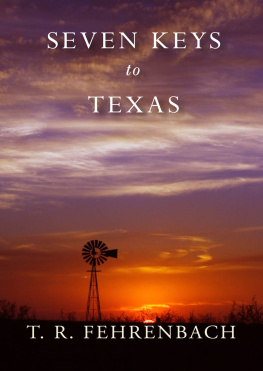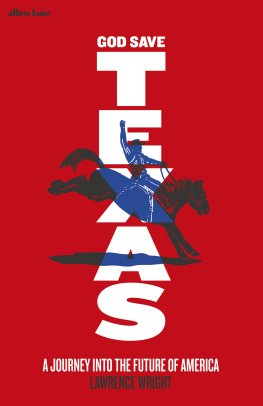Stephen Harrigan - Big Wonderful Thing: A History of Texas (Texas Bookshelf)
Here you can read online Stephen Harrigan - Big Wonderful Thing: A History of Texas (Texas Bookshelf) full text of the book (entire story) in english for free. Download pdf and epub, get meaning, cover and reviews about this ebook. year: 1956, publisher: University of Texas Press, genre: History. Description of the work, (preface) as well as reviews are available. Best literature library LitArk.com created for fans of good reading and offers a wide selection of genres:
Romance novel
Science fiction
Adventure
Detective
Science
History
Home and family
Prose
Art
Politics
Computer
Non-fiction
Religion
Business
Children
Humor
Choose a favorite category and find really read worthwhile books. Enjoy immersion in the world of imagination, feel the emotions of the characters or learn something new for yourself, make an fascinating discovery.

- Book:Big Wonderful Thing: A History of Texas (Texas Bookshelf)
- Author:
- Publisher:University of Texas Press
- Genre:
- Year:1956
- Rating:3 / 5
- Favourites:Add to favourites
- Your mark:
- 60
- 1
- 2
- 3
- 4
- 5
Big Wonderful Thing: A History of Texas (Texas Bookshelf): summary, description and annotation
We offer to read an annotation, description, summary or preface (depends on what the author of the book "Big Wonderful Thing: A History of Texas (Texas Bookshelf)" wrote himself). If you haven't found the necessary information about the book — write in the comments, we will try to find it.
Big Wonderful Thing: A History of Texas (Texas Bookshelf) — read online for free the complete book (whole text) full work
Below is the text of the book, divided by pages. System saving the place of the last page read, allows you to conveniently read the book "Big Wonderful Thing: A History of Texas (Texas Bookshelf)" online for free, without having to search again every time where you left off. Put a bookmark, and you can go to the page where you finished reading at any time.
Font size:
Interval:
Bookmark:
ALSO BY STEPHEN HARRIGAN
FICTION
A Friend of Mr. Lincoln
Remember Ben Clayton
Challenger Park
The Gates of the Alamo
Jacobs Well
Aransas
NONFICTION
The Eye of the Mammoth: New and Selected Essays
Water and Light: A Divers Journey to a Coral Reef
Comanche Midnight
A Natural State: Essays on Texas
THE PUBLICATION OF THIS BOOK WAS MADE POSSIBLE BY THE GENEROUS SUPPORT OF THE FOLLOWING:
Christine and Charles Aubrey
Roger W. Fullington
Jeanne and Mickey Klein
Marsha and John Kleinheinz
Lowell H. Lebermann, Jr.
Joyce and Harvey Mitchell
Office of UT President William Powers, Jr.
Ellen and Ed Randall
Jean and Dan Rather
Tocker Foundation
Judith Willcott and Laurence Miller
Suzanne and Marc Winkelman
big wonderful thing
A HISTORY OF TEXAS
Stephen Harrigan

UNIVERSITY OF TEXAS PRESS
AUSTIN
THE TEXAS BOOKSHELF
The theme song from The Adventures of Jim Bowie is quoted on page 132. 1956 (Renewed 2002) Flea Market Music, Inc. Reprinted by permission of Flea Market Music, Inc.
A stanza from The End of the Line by Bonnie Parker appears on page 547. Dallas Police Department Historial Reports, Records, and Newsletters, 1930Current (Box 13, Folder 14), Dallas Municipal Archives, City Secretarys Office, City of Dallas.
Lines from Negro Hero by Gwendolyn Brooks, on page 596, are reprinted by consent of Brooks Permissions.
What are you looking at me for?, on page 820, is from The Facts of Life: And Other Dirty Jokes by Willie Nelson, copyright 2002 by Willie Nelson. Used by permission of Random House, an imprint and division of Penguin Random House LLC. All rights reserved.
Copyright 2019 by Stephen Harrigan
All rights reserved
First edition, 2019
Requests for permission to reproduce material from this work should be sent to:
Permissions
University of Texas Press
P.O. Box 7819
Austin, TX 78713-7819
utpress.utexas.edu/rp-form
Library of Congress Cataloging-in-Publication Data
Names: Harrigan, Stephen, 1948, author.
Title: Big wonderful thing : a history of Texas / Stephen Harrigan.
Description: First edition. | Austin : University of Texas Press, 2019. | Series: The Texas bookshelf | Includes bibliographical references and index.
Identifiers: LCCN 2018060912
ISBN 978-0-292-75951-0 (cloth : alk. paper)
ISBN 978-1-4773-2003-7 (library e-book)
ISBN 978-1-4773-2004-4 (nonlibrary e-book)
Subjects: LCSH: TexasHistory.
Classification: LCC F386 .H267 2019 | DDC 976.4dc23
LC record available at https://lccn.loc.gov/2018060912
doi:10.7560/759510
For Sonny and Gladys
I hope that a dead calm will reign all over Texas for many years to comeand that there will be no more excitements of any kind whatever.
STEPHEN F. AUSTIN, FEBRUARY 6, 1835

CONTENTS
I couldnt be lieve Texas was real.... the same big wonderful thing that oceans and the highest mountains are.
GEORGIA OKEEFFE
Prologue
BIG TEX
THE FIRE STARTED IN BIG TEXS RIGHT BOOT. IT WAS October 2012. Big Tex was fifty-two feet high and sixty years old. He had come into being when the chamber of commerce of Kerens, Texas, decided to build the worlds largest Santa Claus as a lure to draw Christmas shoppers to their little East Texas town. Beneath his Santa suit of painted oilcloth was a sturdy armature made of drill pipe and structural steel scavenged from nearby oil fields. The giant Santa generated considerable attention at first, but after a windstorm blew away his clothes and the initial excitement of his presence wore off, the figure was sold to the State Fair of Texas in 1951 for $750. He was retrofitted as a cowboy and placed in front of the Cotton Bowl in Dallas, where he greeted fair visitors for the next six decades.
Big Tex had a massive hinged jaw that opened and closed to an approximation of the welcoming words Howdy, folks! broadcast over loudspeakers by an announcer with an impeccably unhurried Texas accent. His outfits changed somewhat over the years, but he always wore a cowboy hat and jeans and a belt buckle as big as a turkey platter. His right arm, bent at the elbow, waved stiffly at fairgoers. His left arm, flung out awkwardly against the blue sky in a gesture meant to seem expansive, looked painfully broken.
For all his creepiness, Big Tex was beloved, a nostalgic reminder of a midcentury time when Texas had agreed to embrace a gentle caricature of itself as a cowboy state, outsized and outlandish, proudly unconcerned with taste. Big Tex was a homely, homegrown icon, the sort of thing that was featured along with the Alamo and the Astrodome on souvenir dinner plates and illustrated tourist maps.
The cause of the fire was an electrical short at the base of the figure, but the first indication that something was wrong with Big Tex appeared much higher up when greasy black smoke began to seep from beneath his shirt collar. Soon, bright flames crept up to consume his face and cowboy hat, and then they appeared along the crotch and seams of his jeans. Within a few minutes the conflagration was complete, nothing left but his blackened steel frame, his right hand, and the outlines of his charred face.
In less than a year, in time for the next state fair, a new Big Tex was erected in the same spot. The updated version cost half a million dollars, was three feet taller and nineteen thousand pounds heavier. But the sight of the new Big Tex being unveiled could not eclipse the weirdly horrifying image of the old one in flames. Its too much to say that the original Big Tex was a symbol of a simpler timethere have been no simple times in Texas historybut it belonged to a different Texas, a Texas that had not yet entered an age of ironic reflection. The new Big Tex was sort of a joke in the way the old one never had been. Everyone understood that it had been reconstructed simply for nostalgias sake, to fill an empty place in the Lone Star psyche. But it was no longer possible for a single imagethat of a waving, welcoming cowboyto truly evoke the heaving twenty-first-century mix of cultural allegiances and colliding identities that Texas had become.
Both the original Big Tex and the new one stood dead center in the very place where that old half-mythical cohesive identity had been codified and triumphantly proclaimed to the world. Fair Park, which is a few miles east of downtown Dallas, is not just the location of the annual state fair and the Cotton Bowl football stadium. It was also the site of the 1936 Texas Centennial Exposition, the gigantic birthday party that Texas staged for itself on the occasion of the 100th anniversary of its independence from Mexico. One of the core goals of the exposition was to Texanize Texans, to acquaint the citizens of the state with the marvels of its industrial might and its unparalleled history. It was also an announcement to the rest of the world of the states poignantly unguarded self-love, a way to mirror the accomplishments of Texas to all the sons and daughters of earth.
Most of the art moderne buildings of the great exposition are still there in Fair Park, hauntingly so. When there is no football game in the Cotton Bowl, no state fair in session, the grounds are often empty. The vast exhibition edifices, with their gilded sculptures and heroic friezes, still flank the grand esplanade, where fountains lining a seven-hundred-foot reflecting pool are programmed to erupt in rhythm with The Yellow Rose of Texas. But the place looks like an abandoned movie set from some futuristic epic of long ago. The exposition had been created on the scale of a Worlds Fair. It was rushed into being with remarkable speed, more than fifty new buildings thrown up in the hinterlands of Dallas in less than ten months. There were life-size robotic dinosaurs, a reproduction of the Globe Theatre, a colossal cash register on top of the National Cash Register Building that tallied up the number of each days visitorsan average of about 36,000. The exhibition halls displayed new advances in electricity, transportation, and domestic life. There was a meant-to-be-progressive Hall of Negro Life, where visitors could learn about black Americans patient, loyal, patriotic attitude toward their country and... their gifts of soul and song. And somehow, there in the middle of Dallas, which would become famous as one of the most morally repressive cities in the country, there was a sanctioned Streets of Paris section, whose artistic focal point was live naked women. The best glimpse of them was via an attraction that passed itself off as an artists studio, where patrons were handed a pad and pencil and shuffled quickly along so that they could sketch a nude model.
Next pageFont size:
Interval:
Bookmark:
Similar books «Big Wonderful Thing: A History of Texas (Texas Bookshelf)»
Look at similar books to Big Wonderful Thing: A History of Texas (Texas Bookshelf). We have selected literature similar in name and meaning in the hope of providing readers with more options to find new, interesting, not yet read works.
Discussion, reviews of the book Big Wonderful Thing: A History of Texas (Texas Bookshelf) and just readers' own opinions. Leave your comments, write what you think about the work, its meaning or the main characters. Specify what exactly you liked and what you didn't like, and why you think so.




